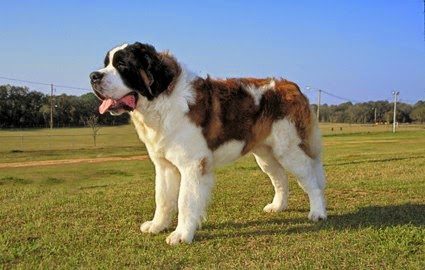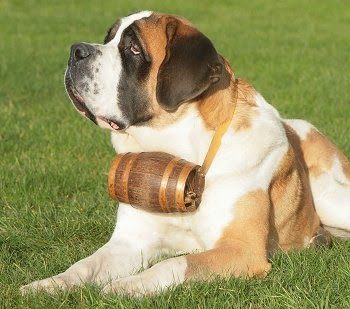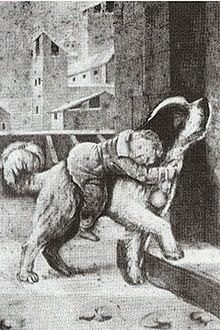The imposing Saint Bernard is powerful and proportionately tall. It is strong and well-muscled — necessary qualities in a dog that must trek through deep snow for miles. Its coat comes in two types: smooth, in which the short hair is very dense and tough, and long, in which the medium-length hair is straight to slightly wavy. Its expression should appear intelligent.
The calm, easy going Saint Bernard is gentle and patient around children, although it is not particularly playful. It is devoted to it`s family and is willing to please, although at its own pace. It can be stubborn.
Overview

No, the Saint Bernard never wore a miniature brandy keg around his neck. The image was merely the product of artistic license taken by Edwin Landseer, who painted a portrait of the breed while visiting Switzerland in 1819. The public loved it, and the brandy keg remains a symbol of the breed to this day.
It’s true, though, that monks at the hospice of Saint Bernard, high in the Swiss Alps, used the dogs to seek out and rescue lost travelers. These days, the Saint is primarily a family companion or show dog, beloved for his calm and patient temperament. The Saint Bernard has many good qualities, but he may also have health and temperament issues. If you want the calm, protective dog of legend, be prepared to do a lot of homework to find him and put in plenty of effort training and socializing him once you bring him home.
The Saint Bernard is a member of the Mastiff family, as evidenced by his huge head and tall, powerful body. He is gentle, but his size alone is enough to deter many would-be intruders or assailants. He is only moderately active, making him suited to homes with small yards. He drools and is sensitive to heat, so he must live in air-conditioned comfort in hot climates.

This is a giant breed. A 25-pound Saint Bernard puppy certainly looks manageable, but he will eventually weigh 120 to 180 or more pounds. His huge size is often what attracts people to him, but the tradeoff is a heartbreakingly short life span of approximately 7 to 10 years. And if you reach your home by stairs and should ever need to haul him up and down, you might be in trouble. If none of that fazes you, a Saint Bernard may well be your dog.
Contrary to his size, the Saint Bernard’s food and exercise needs are modest. He doesn’t eat more than any other large breed dog, and he will be satisfied with a couple of short walks daily. Like any dog, Saint puppies are inveterate chewers and because of their size can do more damage than puppies of other breeds. They are prone to ingesting items such as socks and dish towels, resulting in veterinary visits or even surgery for intestinal blockages.
Though you might think of him as an outdoor dog, the Saint Bernard loves his people and will pine without human companionship. They are also prone to heatstroke and should never be left outdoors for a long time in hot weather. Saints should have access to a securely fenced yard, but when the family is home, the dog should be with them indoors.
Highlights
- A Saint Bernard is a giant-size breed and although they are generally quiet inside, they are not best suited to apartments. They need space to move or just to stretch out in.
- If you consider yourself a neat freak, then the Saint Bernard is not the breed for you. They drool and their paws track in their fair share of mud. They are heavy shedders and shed, or blow, their coat twice a year.
- Saint Bernards generally take longer to mature mentally. This leaves you with a very big puppy for several years.
- Although Saint Bernards make wonderful family pets, they are not recommended for homes with young children, as they can unintentionally knock over and hurt small children.
- Originally bred to withstand the cold temperatures of the Alps, the Saint Bernard does not do well in heat.
- Saint Bernards are not known for barking without cause.
- Saint Bernards are a short-lived breed, usually only 8 to 10 years.
- The Saint Bernard should not live outdoors away from his family. All dogs do better when they are in the house with the family they love, and the Saint Bernard is no exception. Although their coats and build make them an obvious choice for outdoor living, their temperament and inability to cope with heat makes it a poor decision.
- Thanks to the popularity of movies such as Beethoven, which features a large Saint Bernard, many irresponsible breeders and puppy mills produce these gentle giants. To make sure you get a healthy dog, never buy a puppy from an irresponsible breeder, puppy mill, or pet store. Look for a reputable breeder who tests her breeding dogs to make sure they’re free of genetic diseases that they might pass onto the puppies, and that they have sound temperaments.
Other Quick Facts
- The Saint Bernard drools. Don’t believe a breeder who claims to produce “dry-mouth” Saints.
- Saint Bernards excel at dog sports such as drafting, weight-pulling, and obedience trials.
- The Saint Bernard’s coat can be long or short and ranges from deep brown to red brownish-yellow with white markings.
- Comparable Breeds: Newfoundland, Great Pyrenees
History
The Saint Bernard probably has its roots in the Roman Molossian dogs, but it wasn’t until between 1660 and 1670 that the breed developed into the magnificent dog responsible for saving so many lives. Around this time, the first of these large dogs arrived at the St. Bernard Hospice, a refuge for travelers crossing between Switzerland and Italy.
The Saint Bernards originally came to help pull carts and turn spits and may have also functioned as watchdogs or companions, but the monks soon found them invaluable pathfinders through the deep snow. The dogs were adept at locating lost travelers. When a dog found a person, it would lick the person’s face and lie beside him, thus reviving and warming the person. The dogs continued to serve in this invaluable role for three centuries, saving over 2,000 lives.
The most famous of all Saint Bernards was Barry, who was credited with saving 40 lives. Before Barry’s death, the dogs were known by several names, including hospice dogs, but by the time he died he was of such fame that the dogs were called Barryhund in his honor. In the early 1800s many of the dogs were lost to severe weather, disease and inbreeding. Some of the remaining dogs were crossed with Newfoundlands in 1830.
As a result, the first long-coated dogs of Saint Bernard type appeared. Although it seemed that long hair would help a dog in the cold snow, in fact it hindered them as the ice clung to the coat. Thus, these long-haired dogs were not kept for rescue work. The first Saints came to England around 1810 and were referred to by many different names, among them sacred dog. By 1865, the name Saint Bernard was in common use, and it became the official name in 1880.
Around this time, the breed caught the eye of American fanciers. By 1900, the Saint Bernard was extremely popular. Although it has since vacillated in popularity, it is always one of the most popular giant breeds.
“St. Bernard” wasn’t in widespread use until the middle of the 19th century. The dogs were called “Saint Dogs”, “Noble Steeds”, “Alpenmastiff”, or “Barry Dogs” before that time.
True to their heritage as hospice dogs, Saints are friendly and welcoming. They have a steady, benevolent temperament and are kind and careful with children. They love attention but aren’t as demanding of it as some breeds.
Because of their large size, it’s important to begin training Saints at an early age, while they’re still easily manageable. They’re intelligent and willing to please but sometimes stubborn. They should never be aggressive unless it’s in defense of a family member.
Like every dog, Saint Bernards need early socialization — exposure to many different people, sights, sounds, and experiences — when they’re young. Socialization helps ensure that your Saint Bernard puppy grows up to be a well-rounded dog.
Health
The very fast growth rate and the weight of a St. Bernard can lead to very serious deterioration of the bones if the dog does not get proper food and exercise. Many dogs are genetically affected by hip dysplasia or elbow dysplasia. Osteosarcoma has been shown to be hereditary in the breed.They are susceptible to eye disorders called entropion and ectropion, in which the eyelid turns in or out. The breed standard indicates that this is a major fault. The breed is also susceptible to epilepsy and seizures, a heart disease called dilated cardiomyopathy, and eczema.
US and UK breed clubs put the average lifespan for a St. Bernard at 8–10 years.A 2003 Danish breed survey puts the median lifespan at 9.5 years while a UK breed survey in 2004 puts the median lifespan at 7 years. In the UK survey about one in five lived to >10 years with the longest lived dog at 12 years and 9 months.
Care
The daily exercise requirements of the Saint Bernard are met with short runs and moderate walks. The dog is best when raised outdoors, keeping it away from smooth surfaces. Oversized puppies, which are brought up indoors, are susceptible to hip problems.
The Saint Bernard is not tolerant of heat; in fact, it loves cold weather. It does best when given access to the yard and the house. The coat requires weekly brushing and more frequently during shedding season. In addition, many St. Bernards have a tendency to drool.
Living Conditions
The Saint Bernard will do okay in an apartment if it is sufficiently exercised. These dogs are relatively inactive indoors and a small yard is sufficient. They can live outdoors, but would much rather be with their family. They have a low tolerance for hot weather, warm rooms and cars. Can wheeze and snore.
Exercise
A long walk each day is needed to keep the Saint Bernard in good mental and physical condition. Puppies should not have too much exercise at one time until their bones are well formed and strong. Short walks and brief play sessions are best until the dog is about two years old.
Grooming
Saint Bernards come in two coat types: shorthaired and longhaired. The shorthaired Saint has a dense, smooth coat. His longhaired brother has a medium-length coat that is slightly wavy. Either coat type can be white with red or red with white.
Both varieties shed heavily in spring and fall and need weekly brushing year-round to keep loose hair under control. It’s probably a good idea to brush a longhaired Saint a couple of times a week.
Clean the ears and trim the nails as needed, and bathe the Saint when he’s dirty. You’ll want to wipe his mouth after your Saint eats or drinks — before he shakes his head and slings water, drool, or food debris everywhere. Brush his teeth with a vet-approved pet toothpaste for good overall health and fresh breath.
Saints are, well, saintly around kids. Patient and gentle, they step carefully around them and will put up with a lot. That doesn’t mean they should have to, though. Supervise interactions between young children and Saints to make sure there’s no ear- or tail-pulling, biting, or climbing on or knocking over on the part of either party.
Always teach children how to approach and touch dogs and never to approach any dog while he’s sleeping or eating or to try to take the dog’s food away. No dog, no matter how trustworthy or well trained, should ever be left unsupervised with a child.
Saints can also get along well with other pets, especially if they’re introduced to them in puppyhood. Supervise them around smaller dogs and cats just to make sure they don’t accidentally step or lie on them.
Record size
An 1895 New York Times report mentions a St. Bernard named Major F. measuring 8 feet 6 inches (2.59 m) in length, who, if the claims are true, would be the longest dog in history.Another St. Bernard named Benedictine V Schwarzwald Hof (Pierson, Michigan – USA) also reached 315 lb (143 kg), which earned a place in the 1981 edition of the Guinness Book of World Records.
Famous St. Bernards
- Bamse, a Norwegian dog honoured for exploits during World War II memorial statue in Montrose, Scotland where he died in 1944
- Barry, famous Alpine rescue dog
- Bernie, mascot of the Colorado Avalanche
- Bernie “Saint” Bernard, mascot of the Siena Saints
- Bernie, mascot of the Northampton Saints
- Gumbo, team mascot for the New Orleans Saints
- Porthos, J.M. Barrie’s dog
- Schnorbitz, on-stage partner of British comedian Bernie Winters during his later career
- Schotzie & Schotzie “02”, beloved pets and mascots of Cincinnati Reds’ owner Marge Schott
- Scipio Saint Bernard of Orville Wright
- Shirley Temple and a St. Bernard friend
- Wallace , mascot of The Canadian Scottish Regiment (Princess Mary’s)
- Båtsman, a St. Bernard in Astrid Lindgren’s story Vi på Saltkråkan
- Beethoven. The 1992 comedy film Beethoven features a large, friendly but troublesome St. Bernard and, in later sequels, his mate and their brood of unruly pups. According to the producers of the sequel Beethoven’s 2nd, the St. Bernards used in the film grew so fast during filming that over 100 St. Bernard puppies were cast to portray the sequel’s four puppies and a mother St. Bernard named Missy.
- Bolivar a/k/a Bornworthy and Bernie, Donald Duck’s non-anthropomorphic pet, and Bolivar’s son, Behemoth
- Buck, from Jack London’s novel, The Call of the Wild, is described as half St. Bernard and half “Scotch shepherd dog”, but was rendered as full St. Bernard in at least one of the six movie versions.
- Cujo, a dog who contracts rabies and becomes crazed, terrorizing the residents of the fictional town of Castle Rock, Maine from the 1981 Stephen King novel Cujo and the 1983 film of the same name.
- George, from the 1971 movie George! and its 1972–74 spinoff television series.
- Nana, in the Disney and Columbia Pictures Peter Pan movies
- Neil, the martini-slurping St. Bernard of George and Marion Kerby in the 1950s television series Topper.
Legends
The famous Barry found a small boy in the snow and persuaded the boy to climb on his back, and then carried the boy to safety.
A St Bernard named Major is often credited with being the dog that helped save Manchester United, currently one of the world’s largest football clubs, from financial ruin. The legend goes that in 1902 when the club owed sizable debts, the then captain Harry Stafford was showing off his prized St Bernard at a fund-raiser for the club when he was approached by a wealthy brewery owner, J.H.Davis, who enquired to buy the dog. Harry Stafford refused the offer but managed to convince him to buy the club thus saving Manchester United from going bankrupt.
Did You Know?
It’s true that the Saint Bernard was a savior to stranded travelers in the Swiss Alps, but he never wore a brandy keg around his neck.











